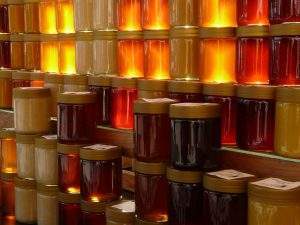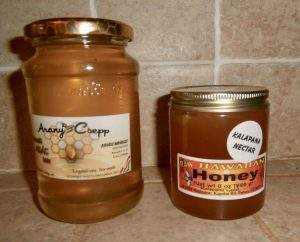Selling Your Honey

There is nothing better than being able to extract and enjoy your own honey. Once you have a surplus, it’s time to think about giving away and selling your honey.
Honey Demand is Increasing
Mintel, a market intelligence agency, reported that honey sales increased 57% from 2011 to 2016. This growth is higher than all types of artificial sweeteners.
Research from the University of Delaware has found that consumers value local honey, and are willing to pay more than for honey originating from international sources.
Quality
Many different surveys have indicated that consumers want to know what is in their food and where their food comes from.
In 2013, some Chinese companies were caught “honey laundering”, substituting artificial honey for the real thing. This fake honey contained zero percent real honey and also traces of aluminum residue. This questionable cargo was then exported to the US and other countries. It was then considered the largest food fraud in US history, totaling about 80 million dollars.
Many Chinese honey brokers will now transport their honey to Asian countries, such as Taiwan or Malaysia and re-label their products.
This is a great opportunity for local honey producers able to label their products “Locally Produced” or “Made in USA”.
 Packaging
Packaging
You can choose to package your honey in plastic or glass jars, which may be purchased from a beekeeping supply company.
Honey jars come in all shapes and sizes, with the “bear” shape being one of the most popular.
While glass bottles are more expensive and cost more to ship, the perception is that the product is of a higher quality.
Many local honey producers use Mason jars purchased at discount stores, such as big Lots.
Honey Categories
Honey is categorized into different categories, depending on extraction method and how it is processed.
Here are three categories of honey typically sold by local producers:
- Liquid honey is honey in which the wax capping has been cut and the honey is then extracted using a honey extractor.
- Comb honey is honey, which is still contained within its original hexagonal-shaped beeswax cells. This honey has not been subject to processing or filtering
- Chunk honey contains one or more honeycomb pieces with extracted honey poured on top.
Labeling Requirements
 All honey sold should have a label that clearly identifies the product as honey. The label must be easily read. You may call your honey “Wildflower Honey” if your bees forage locally, and not on one particular crop. If your bees are pollinating a specific crop or trees, such as sourwood or clover, you may label it as such.
All honey sold should have a label that clearly identifies the product as honey. The label must be easily read. You may call your honey “Wildflower Honey” if your bees forage locally, and not on one particular crop. If your bees are pollinating a specific crop or trees, such as sourwood or clover, you may label it as such.
The weight must be indicated in both ounces and grams (excluding the packaging). The weight must be displayed on the lower third of your label.
The label should include your name, address, phone number and website as well.
It is a good idea to put a warning label, reminding folks that children under 12 months should not ingest honey.
Please be sure to check with your state Department of Agriculture for their state-specific labeling requirements.
Marketing
There are more than 500 honey brands available to consumers in the US. Marketing will help you stand out from the competition.
A professional logo will help consumers identify your unique brand. There are many providers, such as Fiverr.com, where you can have a logo made inexpensively.
You can also aim for certifications such as USDA organic, Non-GMO, or “True Source Honey”, a nonprofit that certifies the quality and origins of its members honey. While expensive, these certifications will help you distinguish your brand from others.
Selling Artisan and Varietal Honeys
A good way to differentiate your product from the competition is to offer artisanal and varietal honeys, such as:
- Acacia Honey
- Avocado Blossom
- Orange Blossom
- Sourwood Blossom
I’ve even seen one marketer offer “Tea Honey”, or honey that is especially good with tea.
One of the latest trends is cannibas infused honey. Please make sure it is legal in your area before selling this type of honey.
The benefit of offering artisan and varietal honey is that you can often charge a premium price, say a dollar or two more than standard wildflower honeys.
Pricing
The best way to come up with a price for your honey is to survey your local market. Go to local grocery stores, farmers markets, health food stores and festivals that sell honey.
Compare prices and then determine what all your costs are to figure your ideal selling price. Consider offering discounts for bigger jars, 2-packs and 3-packs.
Since it’s your brand, you can experiment with different pricing strategies.
Giveaways
Large corporations have used sampling for decades, to introduce products and increase sales.
Simply give away small jars of your honey with all your contact information.
You can target friends and family, local companies and even the local Chamber of Commerce.
Gifts
You can advertise your honey as an ideal gift for birthdays, wedding showers, retirement parties, employee appreciation and anniversaries.
You might even approach a local gift basket company, encouraging them to include your local honey in their gift baskets.
Fairs and Festivals
Many honey sellers market their honey through fairs and festivals. Demonstration hives are really popular ways to draw a crowd.
Local Retailers
If you are selling to any retailers you must be willing to sell at a wholesale price. You must be careful to not undercut the price your local retailer is selling at.
The advantage to selling to local stores is that you will be selling by the case, instead of by the jar. Local health food stores are good candidates to sell your honey.
Sell on the Web
Selling on the web is easy and efficient. You can put up a simple website and sell from there, or sell through other platforms, such as Amazon or ebay.com.
Amazon has a program called FBA (Fulfillment by Amazon) that lets you ship your honey to amazon’s warehouse, and they handle fulfillment and customer service. This service generally comes at a price, usually 30% of your retail price.
Selling Benefits and Features of Honey:
Many sellers of honey tend to highlight to health benefits, such as:
Unlike artificial sweeteners, honey contains additional nutritional compounds, like proteins and minerals.
Other marketers promote the local aspect of their honey:
“Every purchase of local honey products benefits your local economy”
Conclusion
Producing and selling your honey is both challenging and rewarding.
The amount of honey you extract and produce may vary from year to year. Building your own brand and varieties of honey takes time and money. You deserve to profit from all your hard work and effort.
Good luck and happy marketing!
1. Ventilated Suit – https://amzn.to/2D1hJBu
(NEW) Ventilated Jacket – https://amzn.to/2Av6piJ
2. Beekeeper YKK Suit Combo – https://amzn.to/2Xk3xLz
3. Beekeeper Journal – https://bit.ly/3xXxFl2
4. YKK Suit – https://amzn.to/2IDJALO
5. Beekeeper Jacket – https://amzn.to/2FirwTW
6. Beekeeping Gloves:
– Goatskin Beekeeping Gloves – https://amzn.to/2GYxBZW
– Cow Leather Beekeeping Gloves – https://amzn.to/2uiSExd
7. Queen Marking Kit – https://amzn.to/2Wm1kCw
– Queen Marking Pens – https://amzn.to/3c4vE8y
–Queen Marking Cage – https://amzn.to/2TDwwdQ

